With grilling season upon us, many restaurateurs and caterers are firing up their commercial grill and dishing out delicious steaks, ribs, sausages, and chicken thighs. If you own a steakhouse, barbecue restaurant, or smokehouse, expertly preparing a variety of meats is essential to the success of your business, leaving the savvy griller constantly on the lookout for new grilling tips.
Whether you’re a grill master or novice, attention to detail leads to big improvements in the flavor, texture, and quality of your grilled meat. If you’re looking for grilling tips that will take your skills to the next level, check out our grilling tips and get a sizzling grill now!
Grilling Tips
Use our grilling tips to learn how to prep your meat for grilling, how to maintain your grill, and how to deliver delicious grilled food.
1. The Best Time to Salt Meat

Salt your meat either an hour in advance or right before you place it on the grill. Cook, writer, and TV personality Jess Pryles, also known as the “Professional Hardcore Carnivore,” explains why:
“Salt is a very powerful seasoning. Not only does it make things infinitely more delicious, but it’s also full of natural alchemy. Salt can draw out moisture from your meat, which is a bad thing for those who like juicy steaks. To avoid this, you either want to salt an hour or so in advance to allow the briny liquid time to reabsorb into the meat, or salt just before the meat hits the grill. Any time in between – particularly that 15-20 minutes prior zone – will not do your steaks justice.”
If you want to let the meat’s natural flavor take center stage, stick to a classic combination of salt and pepper when preparing your steaks or chicken thighs. For a hint of heat, create a dry rub using a mix of spices including paprika, cayenne pepper, ground coriander, onion powder, and garlic powder.
2. Preparing Meat for Grilling in Advance
Allow your steaks and other meats to reach room temperature by removing them from the refrigerator 20-30 minutes before grilling. Don’t forget to set a timer. While meat left outside of the fridge for 20-30 minutes is perfectly safe, letting raw food sit for too long can become dangerous.
Take caution: While grilling room temperature meat is ideal, chilled raw meat will still easily reach safe-to-serve temperatures. However, when completely frozen steaks are thrown directly on the grill, they are often unsafe to consume. In most cases, steaks grilled from frozen will yield meat that is raw in the center and overcooked around the edges. By allowing your meat to come to room temperature before grilling it, you’ll never run the risk of serving meat that is warm on the outside and cold on the inside. Your room temperature meats will not only be safe to consume, but they will also grill faster and more evenly.
When your timer goes off and your meat has reached room temperature, pat it dry with a paper towel. Lightly brush olive oil onto your meat and generously season it.
3. Prepare Your Grill
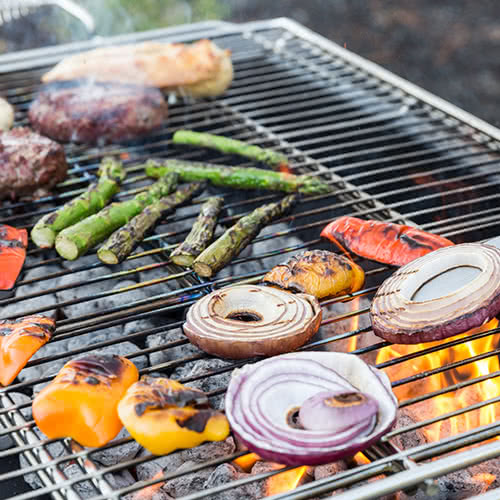
Unsurprisingly, no grilling tips would be complete without addressing the grill itself! For the best results, you need to invest the same level of care and attention into your grill as the meat you’re about to put on it. When preparing your grill, it is important to create various zones for direct and indirect heat.
When using a charcoal grill, don’t cover the entire grill with charcoal briquettes. Instead, create a hot zone in one area of the grill while leaving a separate area off to the side for indirect heat cooking. Creating these hot and warm zones allows you to cook different items at once while providing a safe space for food to cook further away from the flames.
4. How to Gauge Your Grill’s Temperature
Before you place your meat onto the sizzling hot grill, you need to make sure your grill is at the right temperature. There are typically three levels of heat when cooking on a grill: high, medium-high, and medium.
Grill Gauging Trick: Hold your hand about six inches above the grate. If you can withstand the heat for six to seven seconds, you’ve reached medium heat. Four to five tolerable seconds indicate medium-high heat, while one to two bearable seconds means you’re working with a high heat grill.
5. Use a Meat Thermometer
The more you slice, pierce, or puncture meat, the drier it becomes. When you cut into the meat, juices escape, resulting in a disappointing dish. When cooking on the grill, never puncture the meat with a fork or knife. Instead, use tongs or turners to flip meat, and use a high-quality food thermometer to check the internal temperature.
Here’s a breakdown of each heat level on a grill and what meats can be cooked at that temperature:
-
- High Heat: 450°-650° Fahrenheit
High heat is recommended when preparing steaks, pork chops, kabobs, or tuna steak. Getting your grill around 500° Fahrenheit will create a sizzle when the meat hits the grates and produces attractive sear marks your guests will love.
-
- Medium-High Heat: 375°-450° Fahrenheit
Medium-high heat is ideal for cooking hamburgers, vegetables, and fish. This temperature will cook proteins slower to ensure their middle portions reach proper internal temperatures while still creating a searing effect on the meat’s exterior.
-
- Medium Heat: 325°-375° Fahrenheit
Medium heat provides enough warmth to create a satisfying browning effect on the outside of your proteins while still bringing the insides to a proper internal temperature. This makes it ideal for grilling chicken, turkey, roasts, and sausages.
Steak Grill Times and Temperatures
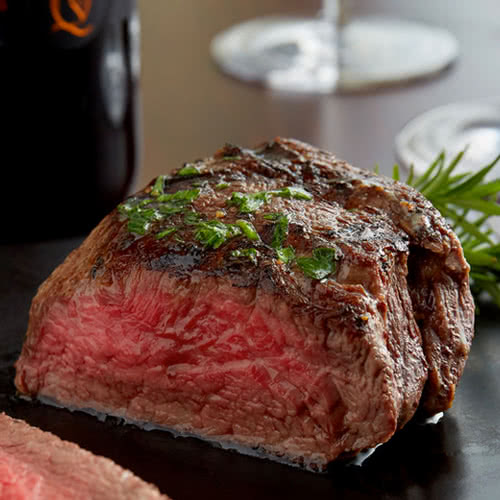
A good steak is a beloved menu item everywhere from sandwich shops serving steak sandwiches to upscale steakhouses. The ideal steak grill times and temperatures fluctuate depending on how you want your steak prepared. You can master the art of achieving the perfect steak by viewing our comprehensive steak doneness guide, or you can introduce yourself to the basics below.
The first step in achieving your ideal steak is setting your grill to the appropriate temperature. While cook time is based on desired consistency, grill temperature is based on the steak’s thickness.
- 1/2″ thick steaks should be cooked at high heat.
- 3/4 to 1″ thick steaks should be cooked at medium-high heat.
- Over 1″ thick steaks should be cooked at medium heat.
Once you achieved the appropriate heat for your meat’s thickness, you’re ready to place your meat on the sizzling grill. Here is how to prepare steaks to achieve each doneness level.
- Extra Rare/”Blue”: Extra rare/”blue” steaks should be grilled for approximately one minute on each side to achieve an internal temperature of 115°-120° Fahrenheit.
- Rare: Rare steaks should be grilled for approximately one and a half minutes on each side to achieve an internal temperature of 125°-130° Fahrenheit.
- Medium-Rare: Medium-rare steaks should be grilled for approximately two minutes on each side to achieve an internal temperature of 130°-140° Fahrenheit.
- Medium: Medium steaks should be grilled for approximately two minutes and fourteen seconds on each side to achieve an internal temperature of 140°-150° Fahrenheit.
- Medium-Well: Medium-well steaks should be grilled for three to four minutes on each side to achieve an internal temperature of 150°-155° Fahrenheit.
- Well-Done: Well-done steaks should be grilled for approximately four to five minutes on each side to achieve an internal temperature of 160°+ Fahrenheit.
6. Delay Saucing Grilled Meat
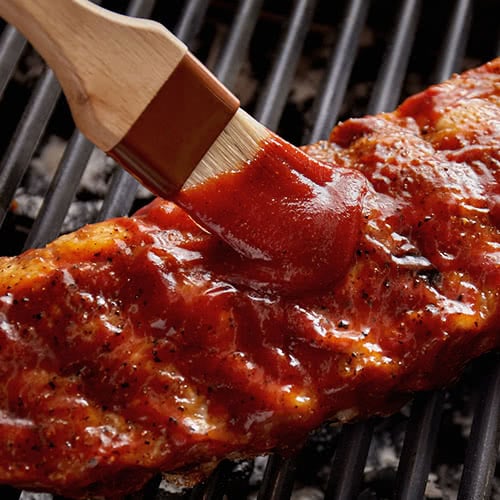
If you cover proteins with a sauce containing sugar before throwing them on the grill, you’ll likely produce charred and burned meat; sugar caramelizes when exposed to high heat. Common culprits include barbecue sauce, fruit glazes, and teriyaki-based sauces.
To avoid this mistake, apply your glazes and sauces during the last few minutes of grilling. You won’t gain any added flavor by trying to include sauces earlier in the grilling process. To achieve a deep flavor that will permeate the entire cut of meat, marinate your meats before grilling.
7. Let Meat Rest
When your grilled meat is served makes or breaks whether your attentive cooking efforts are appreciable. Exact rest times vary, and how long to let steak rest is slightly different than how long you should let chicken rest.
As a general rule, once your meat is cooked through, you should let it rest for 5-10 minutes before serving it. During this time, the juices in your steak, pork chop, chicken thigh, or lamb kabob become evenly distributed throughout the protein for optimal tenderness.
How to Choose a Grill
Now that you know the top grilling tips, it’s time to choose a grill.
In the game of delicious grilled meat, there are two teams: gas and charcoal. In the next section, the two teams square off, revealing the fast facts you need to decide between a gas and charcoal grill.
When you’re ready to make a purchase, use our in-depth outdoor grill guide to make the most informed choice. We explain everything from grill capacities and fixed/portable grill requirements to grill accessories and BTUs.
Gas Grill vs Charcoal Grill
Before learning how to choose a grill, you must understand the difference between a gas and a charcoal grill. In general, gas grills are considered easier to work with because of their temperature controls and steady heat source. Charcoal grills tend to reach higher temperatures, but the temperature is less regulated and there is always the possibility of flare-ups.
Gas Grill
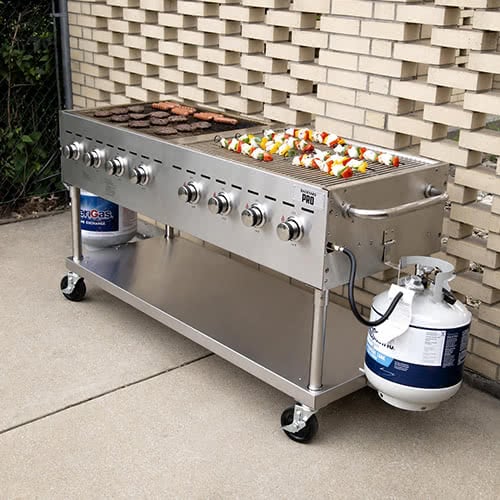
Gas grills offer a time-sensitive, direct-heat grilling method. Fueled by either a propane tank or natural gas, a gas grill allows you to create succulent grilled dishes without tending to a fire.
While natural gas grills exist (grills that connect to gas lines), they are uncommon. The most popular gas grill is the propane grill. Propane grills are fueled by tanks of liquid propane and create more steam inside the grill than charcoal, keeping the meat moist.
When to Use a Gas Grill:
- When you’re grilling thin cuts of meat or tough kinds of meat such as pork chops
- When your time is limited
Charcoal Grill

Charcoal grills use a dense layer of lit coals to cook food. Food grilled over the direct heat emitted by a charcoal grill achieves rich, smoky flavors. Arranging your coals and maintaining even heat emissions requires practice, and meat grilled on a charcoal grill takes longer to cook.
The benefits of charcoal grills are best appreciated in thick steaks, chicken, turkey, and ribs where the deep and smoky flavors permeate into the meat through a long, low, and slow charcoal grilling process.
When to Use a Charcoal Grill:
- When you have plenty of time
- When you want a smokey, campfire flavor
- When you want perfectly grilled fish with a crispy outer layer and moist center
- When you’re grilling a thick cut of meat that is enhanced rather than burned by sear marks
Practical Considerations of Investing in a Gas and Charcoal Grill
To choose between a gas and charcoal grill, you need to honestly assess your intended use, experience level, and flavor preferences. If you feel your most popular dishes could benefit from both methods but you can only invest in one, here are a few practical considerations to help you decide between a gas and charcoal grill.
- Cost: Charcoal grills are less expensive than gas grills.
- Safety: Gas grills are safer than charcoal. Evaluate your working environment and determine whether cooking with burning charcoal is a fire hazard.
- Cleaning: Gas grills are easier to clean.
- Temperature Control: It is easy to adjust the temperature on a gas grill, whereas the lit charcoal takes constant supervision to deliver evenly cooked meat.
- Accessories: Most gas grills are compatible with grilling accessories that create different flavor profiles.
If you want the rich smoky flavor charcoal provides, but your space doesn’t allow you to safely operate a charcoal grill, check out our guide to getting smoky flavor without firing up a grill.
Cleaning Grill Grates
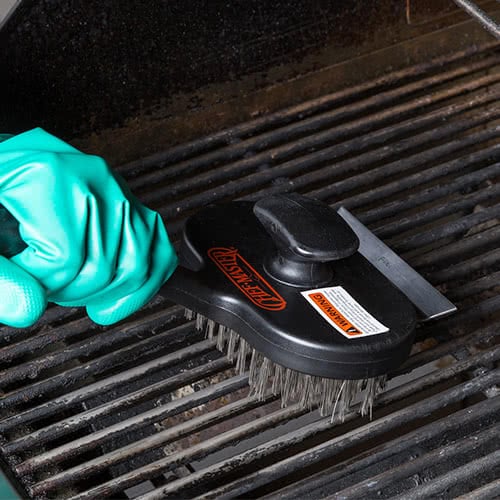
No matter what type of grill you choose to cook with, it’s important to learn how to care for your grill grates and keep them clean in between uses.
Use a grill brush to remove charred food particles left behind after grilling. By neglecting to clean your grill after every use, your food can easily become contaminated with remnants of last night’s dinner. If you’re using a charcoal grill, cleaning grill grates is particularly important because it drastically reduces the chance of flare-ups.
Learning how to choose a grill that will deliver your desired flavor profile and educating yourself on the top grilling tips elevates your dishes above what patrons are grilling at home, pulling them through your doors time and time again. Our grilling tips will turn novice and experienced grillers alike into pitmasters. Get a sizzling grill right now, churning out juicy, succulent meat guests rave about.
Contact us for more information.